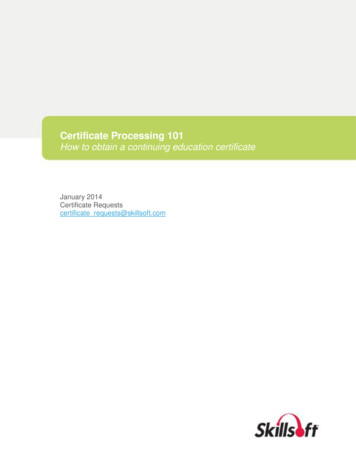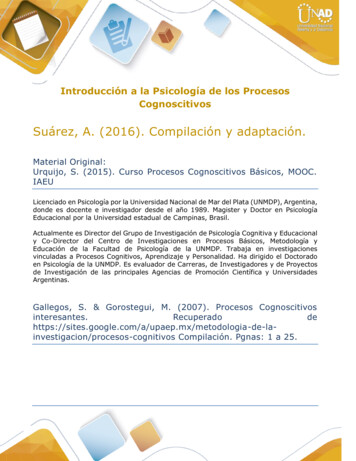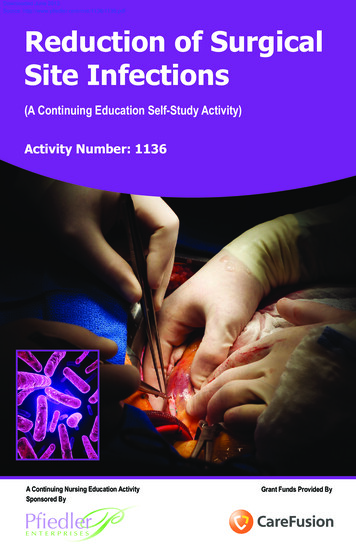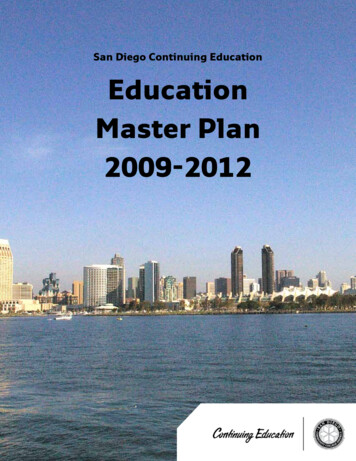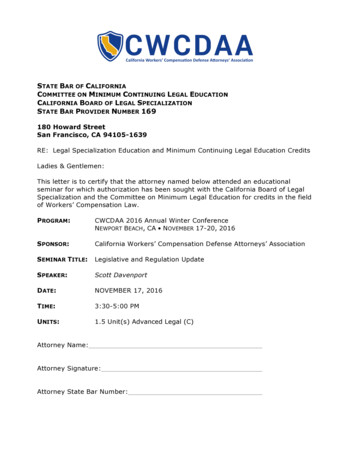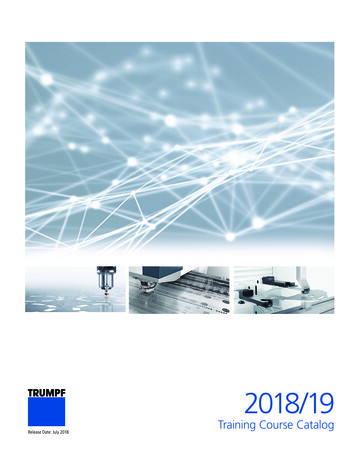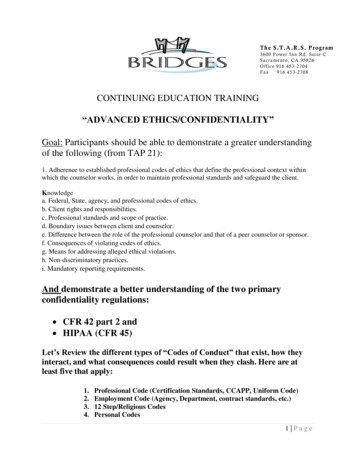
Transcription
The S.T.A.R.S. Program3600 Power Inn Rd. Sui te CSacramento, CA 9582 6Office 91 6 45 3 -2704Fax9 16 45 3 -2708CONTINUING EDUCATION TRAINING“ADVANCED ETHICS/CONFIDENTIALITY”Goal: Participants should be able to demonstrate a greater understandingof the following (from TAP 21):1. Adherence to established professional codes of ethics that define the professional context withinwhich the counselor works, in order to maintain professional standards and safeguard the client.Knowledgea. Federal, State, agency, and professional codes of ethics.b. Client rights and responsibilities.c. Professional standards and scope of practice.d. Boundary issues between client and counselor.e. Difference between the role of the professional counselor and that of a peer counselor or sponsor.f. Consequences of violating codes of ethics.g. Means for addressing alleged ethical violations.h. Non-discriminatory practices.i. Mandatory reporting requirements.And demonstrate a better understanding of the two primaryconfidentiality regulations: CFR 42 part 2 and HIPAA (CFR 45)Let’s Review the different types of “Codes of Conduct” that exist, how theyinteract, and what consequences could result when they clash. Here are atleast five that apply:1.2.3.4.Professional Code (Certification Standards, CCAPP, Uniform Code)Employment Code (Agency, Department, contract standards, etc.)12 Step/Religious CodesPersonal Codes1 Page
5. Law of the Land (in addition to ADP (now DHCS), cooperate withinvestigations – 5th amendment rights, preserving client confidentiality,etc.)Review the CCAPP Scope of Practice and the “Uniform Code of Conduct” inthe pages that follow and consider the following: Think of specific examples of violations of each tenant, and whereappropriate, what should have occurred instead. Consider the nature of a “Dual Relationship” and what damage couldresult from inappropriate Counselor/Participant contact?o Physically touching clients. what is: Appropriate/inappropriate Weak Boundaries/ implied vulnerability Liability risk What are the MOST COMMON ways the Confidentiality of our Clientscould get “broken” by STAFF?oooooFamily members/Partners (Marriage does not override CFR 42)Other agencies not listed on HIPAAWhen you know the person knows Client is here?When we are out in Public?DON’T ASSUME you have a release!!Providing Ethical Services: First things first: In order to be able to provide services Ethically, ANYSTAFF MEMBER needs to have EMPATHY for the client. If you don’tcare about what happens to the client, you cannot Ethically treat orsupport a client. The counseling/staff relationship with the client must remain as pure aspossible. we are NOT the client’s friend, sponsor, facebook buddy,business partner or lover. 2 Page
CALIFORNIA AOD COUNSELORS: CERTIFICANTS AND REGISTRANTS– STANDARDUNIFORM CALIFORNIA AOD COUNSELOR CODE OF CONDUCTAdopted: May 2012Principle 1:Registrants and Certified AOD Counselors shall conduct themselves in an honest, forthrightand professional manner. Registrants and Counselors are prohibited from engaging in thecommission of any dishonest, corrupt, or fraudulent act substantially related to thequalifications, functions or duties of a registrant or counselor including but not limited to thefollowing:a. Securing a registration, certification or renewal by fraud, deceit or misrepresentation onany application or material in support of any application for registration certification orrenewal;b. Misrepresenting the type or status of registration or certification held by the person, orotherwise misrepresenting or permitting misrepresentation of his or her education,professional qualifications or professional affiliations to any person, program or entity;c. Refusal or failure to provide proper identifying registration, credential, certification orlicense where appropriate or required (e.g., when offering or providing AOD counselingservices, on business cards, on informational or marketing materials, etc.);d. Advertising, marketing or promoting programs, services, training, education orexperience in a false and misleading manner, as set forth in Business and ProfessionsCode sections 17200, et seq. Code of Regulations (CCR) Title 9, Division 4, Chapter 8,Sections 13000, et seq., as enacted April 1, 2005. 2 CCR Title 9, Div. 4, Chap. 8, Section13060. 3 CPrinciple 2:Registrants and Certified AOD counselors shall maintain professionally appropriateboundaries with clients and family members of clients and shall conduct themselves in aprofessional, non-exploitive and lawful manner, and are prohibited from:a. Engaging in inappropriate social relationships, sexual relations or soliciting sexualrelations with a client or with a former client within two years from the termination date of thecounseling relationship;b. Committing an act of sexual abuse, misconduct or an act punishable as a sexuallyrelated crime;c. Engaging in a business relationship with clients, patients, program participants, residentsand/or other persons significant to them within one year from the termination of thecounseling relationship;d. Physically, verbally, sexually harassing, threatening or abusing other staff members,clients, patients, program participants, residents and/or other persons significant to any ofthe above;e. Unlawfully administering to himself or herself any controlled substance as defined inSection 4021 of the California Business and Professions Code (B&P), or using any of thedangerous drugs or devices specified in Section 4022 of the B&P, or using any alcoholicbeverage to the extent, or in a manner, as to be dangerous or injurious to the person3 Page
holding or applying for a registration, certification or license or to any other person, or to thepublic.CR Title 9, Div. 4, Chap. 8, Section 13060(f).Principle 3:Registrants and Certified AOD counselors shall comply with all Federal and State Laws andRegulations that pertain to patient/client confidentiality, mandated reporting exceptions,record keeping requirements and patient/client records access. Registrants and CertifiedAOD counselors are prohibited from:a. Violating client/patient confidentiality except as required or permitted by law including, butnot limited to, Title 42 Code of Federal Regulations Part 2, Child Abuse, Elder Abuse andPublic Safety laws and Regulations;b. Failing to maintain records consistent with the nature of the services being rendered;c. Refusing or denying patient/client access to charts and records as required by law;d. Violating, attempting to violate or conspiring to violate any law or regulation governingAOD registrants, certified or licensed AOD counselor.STATEMENT OF AGREEMENT AND UNDERSTANDING:The undersigned hereby understands and agrees to comply with the CCAPPCREDENTIALING code of ethics and uniform code of conduct as outlined in this document.The undersigned also agrees to abide by the California Department of Alcohol and DrugProgram Administrations Code of Conduct outlined in Chapter 8; Subchapter 3, Section13060. The undersigned also understands and consents to the release of informationpertaining to registration or certification, any ethical violation(s) and/or sanctions as part ofthe process of becoming and maintaining a CCAPP CREDENTIALING/CCAPP designationas a member, registrant, or a certificant. The information may be disclosed to the CaliforniaAlcohol/Drug Program Administration, to the California state-approved certification bodiesand/or employers. I further agree not to sue CCAPP or CCAPP CREDENTIALING relativeto the certification/examination process and I agree to indemnify and hold CCAPP andCCAPP CREDENTIALING and their respective officers, directors, agents, and employeesharmless from any and all liabilities, losses, costs, damages, and any other expenses whichCCAPP/CCAPP CREDENTIALING or their officers, directors, agents, and employees maysustain or incur as a result of or arising from the certification examination process. I agree toreimburse CCAPP and/or CCAPP CREDENTIALING for any attorneys’ fees and costsincurred as a result of my breach of this hold harmless provision. I agree to cooperate withcomplaint investigations and supply information requested during complaint investigationsunless such disclosure of information would violate the confidentiality requirements ofSubpart 2, Title 42, Code of Federal Regulations. I understand failure to comply with theEthics Review Committee or DHCS may result in immediate suspension and/or revocationof my registration or certification until such time I comply. I understand the website willinclude the term “pending” until such time the complaint is resolved and/or sanctions arecompleted by respondent; suspensions and revocations will be posted on the publicdatabase (website).4 Page
SCOPE OF PRACTICESubstance Use Disorder Certified Counselors (SUD)Purpose:To assure a consistent standard of quality education, training and experience for alcoholand drug counselors and registrants.Certification/registration is necessary to safeguard the public health, safety, and welfare,and to protect the public from unauthorized services delivered by non-certified alcohol/drugcounselors, and unprofessional contact by certified alcohol/drug counselors.Requirements:a. Competencies required for alcohol/drug counseling include the TAP 21 competencieswhich also include the 12 Core functions: screening, intake, orientation, assessment,treatment planning, counseling, case management, crisis intervention, client education,referral, reports and record keeping, and consultation with other professionals.A SUD Counselor must successfully complete the requirements of each step in the careerpath. Each level of certification has specific competencies and examinations that one mustsuccessfully pass in order to become certified by CCAPP Credentialing.b. The Substance Use Disorder Counselor (in any place of the career path) as previouslydescribed must renew their certification every two (2) years by meeting the following:renewal periodapplication for your specific renewal requirements); 40 advanced hours, 10 professionaldevelopment hours will be accepted (one can complete as many advanced hours he/shechooses, but no less than 40.) A minimum of 6 hours must be specific to Counselor Ethicseach renewal cycle.Role of the SUD COUNSELOR:a. To assist and support clients with alcohol/drug abuse or dependence, their familymembers and others to attain and maintain abstinence as appropriate.b. Develop a program tailored to the individual in support of a recovery process that willeffect an improved quality of living.c. Provide quality professional counseling for clients with alcohol/drug abuse ordependence, their family members and others by means of: providing current and accurateinformation and education on the disease of alcoholism and other drug dependency issuesand recovery processes, assisting in identifying and understanding the defensemechanisms that support continued addiction.d. Facilitate a process for clients to self-explore the consequences of alcoholism and otherdrug dependence.Page 7 of 85 Page
e. Utilize the functions of alcohol/drug counseling including: screening, intake, orientation,assessment, treatment planning, counseling, case management, crisis intervention, clienteducation, referral, reports /record keeping and consultation.f. Assist in relapse prevention planning and recognizing relapse symptoms and behaviorpatterns.g. Provide current and accurate information and education to identification andunderstanding the roles of family members and others in the alcoholism/drug dependencysystem.h. Educate on how self-help groups (for example, Alcoholics Anonymous, Al-Anon, Womenfor Sobriety, Narcotics Anonymous, Secular Organization for Sobriety, Co-dependentsAnonymous, etc.) complement alcoholism/drug addiction or dependency counseling and theunique role of each in the recovery process.i. Assist clients to establish life management skills to support a recovery process.j. Facilitate problem solving and the development of alternatives to alcohol/drug use orabuse and related problems of family members and others.k. Provide support as part of a treatment team and referring clients, family members andothers to other appropriate health professionals as needed.l. Maintain appropriate records in a confidential manner for the purpose of treatmentplanning and case management, provide all services in accordance with the CaliforniaCertification Board of Alcohol and Drug Counselors Code of Ethics.m. Utilize the appropriate skills to assist in developing sobriety life management andcommunication skills that support recovery, including:Active Listening Intervention Leading Confrontation Summarizing Feedback Reflection Concreteness Empathy EducationSetting for the delivery of services:a. A SUD Counselor Associate may conduct counseling of clients with alcohol/drugaddiction or dependence, their family members and others in: Hospitals Agencies Or other facilities where alcohol and/or drug services are deliveredb. An interdisciplinary team in hospitals or other agencies shall include a person licensed bythe State of California under the Medical Practices Act, the Social Work Licensing Law, thePsychology Licensing Act, or the Marriage, Family and Child Counselors Licensing Law atthe setting or delivery of services.c. An independent setting is a professional office location where a SUD Counselor I/II (orEquivalent) supervises the Registrants or Associates. While he/she delivers drug and/oralcohol counseling services to clients with alcohol/drug addiction or dependency, theirfamily members and others.d. To be certified at the reciprocal level (CADC II) the individual must live or work withinCalifornia at least 51% of the time.Definitions:a. A Registered Alcohol and Drug Trainee Level II (RADT II) is a person whopossesses and utilizes a competency-based core of knowledge and skills to assistalcohol/drug-affected persons, and those affected by the alcohol/drug affectedperson; a RADT II is the entry level6 Page
ETHICAL QUESTIONS TO CONSIDER WHEN PROVIDING SERVICES Which Type of Ethical Code is MOST IMPORTANT to YOU and Why?o Certification/Professionalo 12 stepo Religious Which Method of handling an Ethical Quandary is most helpful for you and why?o Approaching person involved firsto Approaching Coworker firsto Approaching Supervisor firsto Approaching Clinical Director firsto “Wait and see” if problem continues If your company hires a new employee that was YOUR CLIENT in a treatment settingprior to them getting “into the field” does that affect your approach with them? How?Does it matter, or how would it affect your approach depending on:o How long ago it was?o WHAT TYPE of setting it was in?o What YOUR role with the client was precisely?o Same sex/different sex?o What your role IN THE COMPANY you work for is? Their role?o CAN you go on to become full fledged Friends eventually? How would you react if a former (3 months ago) CLIENTS FAMILY bought yourapartment complex?o Would you move?o Would you tell someone? Who?o How would you proceed to pay your rent, etc.? What do you say to a family member that is trying to get information on the person whois being treated at your facility (when you don’t have a release?). What is appropriate?o “I can neither confirm nor deny”o “Please read Federal Confidentiality regulations”o “If he WAS here, I could not tell you”o “I’ll get him to sign a release”o “You need to talk to HIM/HER”o “You can just wait and see if he walks by”CORRECT RESPONSE: “I can neither confirm nor deny”.7 Page
CFR 42 Part 2 and HIPAA Confidentiality LAWS: Two laws enacted in the early 1970’s due to the PERCEPTION thatpeople would NOT seek Treatment if they believed their confidentialitymight be breached Guarantee strict confidentiality of information about persons receivingalcohol and drug prevention and treatment services Regulations implementing the statues were issued in 1975 Amended in 1987: Mandated abuse reporting Consolidated the statutes in 1992 (42 U.S.C 290-2), the regulations werenot changed (42 CFR Part 2)A. Purpose of the law:1. To encourage persons with alcohol and drug problems to get help without incurring the risk ofadding to their problems.2. Government has an interest in decreasing the burdens associated with the huge costs of alcohol anddrug abuse problems of our society3. Better use of federal funds. It is more cost effective to encourage a person to get help for AODproblems in a recovery/treatment setting vs. incarcerationB. Why is the law important to AOD Service Providers?n (see flyer attached)-compliance may jeopardize funding AND REPUTATION!!!C. Who Does the Law Apply To?nd/or other organizations assisted by IRS regulationsD. What Does the Law Apply To?8 Page
More interesting facts about CFR 42 Part 2: Applies even if the person seeking the information already has it or hasother ways to obtain it Applies to law enforcement or other official, even with a subpoena Disclosing even the presence of a patient at a facility or unit which isidentified as a place where only drug/alcohol services are providedrequires written authorization The memories and impressions of program staff are considered“records” protected by the regulations even if they are never recordedin any form. A payer or funding source that maintains records of a recipient ofdrug/alcohol treatment becomes subject to 42 CFR Part 2 to the sameextent as the program from which the information came.When protections begin for someone seeking substance abuse treatment:Part 2 protects all information about any person who has applied for or been given diagnosis ortreatment for alcohol or drug abuse at a federally assisted program. See 42 CFR §2.11 (definitionof a “patient”). Information is subject to the Privacy Rule if it is individually identifiableinformation created, received, or maintained by the covered entity. Former patients and deceasedpatients are protected under both Part 2 and the Privacy Rule. See 42 CFR §§2.11 and 2.15 and45 CFR §§164.501 and 164.502(f). Programs should generally continue to follow Part 2, but notethat if PHI is received prior to a patient applying to a program, under the Privacy Rule, suchinformation is protected.9 Page
II.How the Privacy Rule affects disclosures of informationA.The General RuleThe “general rules” established by Part 2 and the Privacy Rule (HIPAA) regarding uses anddisclosures of patient health information are very different.10Substance abuse treatment programs must comply with both rules. Generally, this will mean thatthey will continue to follow Part 2’s general rule and not disclose information unless they canobtain consent or point to an exception to that rule that specifically permits the disclosure.Programs must then make sure that the disclosure is also permissible under the Privacy Rule.B.When disclosures are permitted1.Part 2 Consent11 and Privacy Rule Authorization42 CFR Part 2Programs may not use or disclose anyinformation about any patient unless thepatient has consented in writing (on aform that meets the requirementsestablished by the regulations) or unlessThe Privacy Rule (HIPAA)The Privacy Rule permits uses anddisclosures for “treatment, payment andhealth care operations” as well as certainother disclosures without the individual’sprior written authorization. Disclosures nototherwise specifically permitted or requiredby the Privacy Rule must have anauthorization that meets certainrequirements. With certain exceptions, thePrivacy Rule generally requires that uses anddisclosures of PHI be the minimumnecessary for the intended purpose of the useor disclosure.another very limited exception specifiedPart 2 uses the term “disclosure” to cover what the Privacy Rule refers to as “uses” and “disclosures.” See thein the regulations applies. Any disclosuredefinition of these terms in 45 CFR §160.103. Some Privacy Rule provisions differ for “uses” and “disclosures.” Forconvenience, we generally use the Part 2 term “disclosure” throughout to encompass both uses and disclosures underbeRule.limitedto theinformationthemustPrivacyIn someinstances,however, specific uses or disclosures are discussed.11This document uses the term “consent” when referring to any written permission provided by a patient for the useor disclosureinformation.The Privacy Rule uses the term “authorization” for certainnecessaryoftoidentifiablecarry outhealththe purposeof thepermissions, and also permits, but does not require, programs to obtain “consent” for the use and disclosure of PHIfor purposes of treatment, payment, or health care operations.10disclosure.10 P a g e
Substance abuse treatment programs most often make disclosures after a patient has signed aconsent form that meets the requirements of 42 CFR §2.31. Note that a disclosure under Part 2includes the acknowledgment that someone has applied to or is enrolled in the program, and thusis only permitted if the patient has signed a consent form (or another of the regulations’ narrowexceptions applies). See 42 CFR §§2.11 and 2.13. A Part 2 consent form must include thefollowing elements: Name or general designation of the program or person permitted to make the disclosure;Name or title of the individual or name of the organization to which disclosure is to bemade;Name of the patient;Purpose of the disclosure;How much and what kind of information is to be disclosed;Signature of patient (and, in some States, a parent or guardian);Date on which consent is signed;Statement that the consent is subject to revocation at any time except to the extent that theprogram has already acted on it; andDate, event, or condition upon which consent will expire if not previously revoked.When programs operating under Part 2 disclose information pursuant to a consent form, theymust include a written statement that the information cannot be redisclosed. See 42 CFR §2.32.Revocation of ConsentPart 2 permits a patient to revoke consent orally (see 42 CFR §2.31(a)(8)); the Privacy Rulerequires written revocation of an authorization (45 CFR §164.508(b)(5)). Substance abusetreatment programs must continue to honor verbal revocations but may want to obtain writtenrevocation when possible or at a minimum document the revocation in the patient’s record. BothPart 2 and the Privacy Rule allow the program to make a disclosure for services already rendered11 P a g e
in reliance on a signed consent or authorization form. See 42 CFR §2.31(a)(8) and 45 CFR§164.508(b)(5)(i).2.Other permissible disclosures under CFR 42 Part 2Substance abuse treatment programs are accustomed to complying with Part 2’s general ruleprohibiting disclosure, unless the patient has consented in writing or the disclosure falls withinone of the regulations’ limited exceptions (e.g., child abuse reporting, medical emergencies). Insome instances, the Privacy Rule does not require a change in these practices. In others, thePrivacy Rule will require some modification of programs’ practices.a.When little or no changes may be neededPrograms should generally continue to follow the rules in Part 2 regarding:i.Internal program communicationsBoth Part 2 and the Privacy Rule allow for communications within programs on a “need toknow” basis. Part 2 requires that the communication of information within the program (or to anentity with direct administrative control over the program)14 be limited to those persons whohave a need for the information in connection with their duties that arise out of the provision ofdiagnosis, treatment or referral for treatment of alcohol or drug abuse. See 42 CFR §2.12(c)(3).Similarly, the Privacy Rule requires programs to identify the staff persons or classes of personsin its workforce who need access to PHI, the categories of PHI they need access to, and anyconditions appropriate to such access. See 45 CFR §164.514(d)(2)(i). The program must thenmake reasonable efforts to limit access of such persons or classes of persons to PHI based onthese determinations. See 45 CFR §164.514(d)(2)(ii). Substance abuse treatment programs12 P a g e
subject to the Privacy Rule will have to establish written policies to comply with the minimumnecessary requirement of the Privacy Rule, although in practice, the programs should be able tooperate as they have under Part 2 in this regard.ii.Crimes on program premises or against program personnelPart 2 permits programs to disclose limited information to law enforcement officers. Suchdisclosures must be directly related to crimes and threats to commit crimes on program premisesor against program personnel and must be limited to the circumstances of the incident and thepatient’s status, name, address and last known whereabouts. See 42 CFR §2.12(c)(5). ThePrivacy Rule permits programs to disclose to law enforcement officials PHI that the programbelieves in good faith constitutes evidence of a crime that occurred on the program’s premises.See 45 CFR §164.512(f)(5). It also permits any member of the program’s staff who is the victimof a crime to report certain information about the suspected perpetrator to law enforcementofficials. See 45 CFR §164.502(j)(2). Programs should continue to follow the rules establishedby Part 2.iii.Child abuse reportingPart 2 permits programs to comply with State laws that require the reporting of child abuse andneglect. See 42 CFR §2.12(c)(6). The Privacy Rule also permits such reporting. See 45 CFR§164.512(b)(1)(ii). However, Part 2 limits programs to making only an initial report; it does notallow programs to respond to follow-up requests for information or to subpoenas, unless thepatient has signed a consent form or a court has issued an order that complies with the rule (see“Subpoenas and court-ordered disclosures,” below). Programs should continue to follow therules established by Part 2.13 P a g e
iv.Medical emergenciesPart 2 allows patient-identifying information to be disclosed to medical personnel who have aneed for the information about a patient for the purpose of treating a condition which poses animmediate threat to the health of any individual and which requires immediate medicalintervention. See 42 CFR §2.51. A program can disclose information only to medical personneland must limit the amount of information to that which is necessary to treat the emergencymedical condition. Immediately following the disclosure, the program must document thefollowing in the patient’s records: The name and affiliation of the medical personnel to whom disclosure was made;The name of the individual making the disclosure;The date and time of the disclosure; andThe nature of the emergency.These practices are not affected by the Privacy Rule.v.Subpoenas and court-ordered disclosuresPart 2 permits programs to release information in response to a subpoena if the patient signs aconsent permitting release of the information requested in the subpoena. When the patient doesnot consent, Part 2 prohibits programs from releasing information in response to a subpoena,unless a court has issued an order that complies with the rule. See 42 CFR Part 2, Subpart E.Subpart E sets out the procedure the court must follow, the findings it must make, and the limitsit must place on any disclosure it authorizes.The Privacy Rule (HIPAA – NOT CFR 42 Part 2!!) permits a program to disclose PHIpursuant to a subpoena without a prior written authorization, if it receives satisfactoryassurance from the party seeking the information that reasonable efforts have been madeto ensure that the individual has been given notice of the request for PHI and the14 P a g e
opportunity to object, or reasonable efforts have been made to secure a qualified protectiveorder. See 45 CFR §164.512(e)(1)(ii). The Privacy Rule has different requirements regardingcourt orders, but programs can comply with both Part 2 and the Privacy Rule by continuing tofollow the Part 2’s court order requirements. Unless the disclosure requires authorization underthe Privacy Rule, the Part 2 consent form can be used.Proposed Rule Modifies 42 CFR Part 2, theConfidentiality of Alcohol and Drug Abuse PatientRecords RegulationsBy Kelly McGeeCopyright 2016, American Health Lawyers Association, Washington, DC.Reprint permission granted.On February 5, the U.S. Substance Abuse and Mental Health Services Administration(SAMHSA) announced proposed revisions to 42 CFR Part 2 (Part 2). Promulgated in 1975, Part2 was intended to provide additional confidentiality protections to patient records related totreatment for alcohol and drug use. The last substantive amendments to Part 2 were in 1987,prior to the advent of electronic health records, accountable care organizations (ACOs), andother health care system developments. The proposed rule is based in part on a series ofactivities conducted by SAMHSA in 2014 to gather stakeholder feedback and comments on thecurrent regulations.SAMSHA designed the changes “to increase opportunities for individuals with substance usedisorders to participate in new and emerging health and health care models and healthinformation technology.” Additionally, this proposed rule recognizes the widespread use ofelectronic records and updates the terminology to reflect that. SAMHSA also acknowledges aneed for disclosing Part 2 data for scientific research purposes to promote understanding oftreatment for addiction and other health issues.CHANGES TO KEY DEFINITIONSThe proposed rule revises certain key terms in Part 2, including, as follows: “Part 2 Program” is added to clarify that programs that are federally assisted must abide by theconfidentiality protections of Part 2.15 P a g e
“Records” is revised to include any information, recorded or not, received or acquired by a Part2 Program relating to a patient, including paper or electronic form. “Substance use disorder” replaces “alcohol abuse” and “drug abuse” and refers t
a. Competencies required for alcohol/drug counseling include the TAP 21 competencies which also include the 12 Core functions: screening, intake, orientation, assessment, treatment planning, counseling, case management, crisis intervention, client education, referral, reports and record keeping, and consultation with other professionals.

